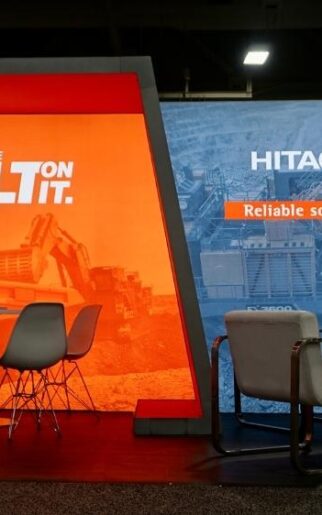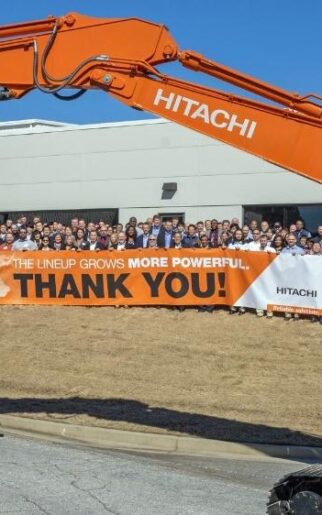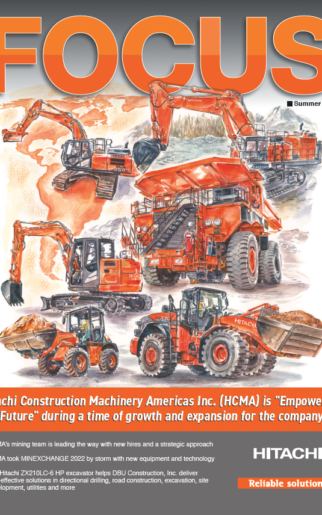Quiet times are rare on Seattle’s Lower Duwamish Waterway, the centerpiece of a bustling industrial corridor that plays a critical role in the Puget Sound area’s economy. Bordered by a wide variety of manufacturing plants and support operations, the Duwamish serves as a marine “main street” for barges delivering bulk loads of raw materials from around the world. And as each shipment arrives, the plants’ tightly timed production and supply processes demand that the materials be unloaded as quickly and efficiently as possible.
That’s where Industrial Services, Inc. (ISI) comes in. Armed with a fleet of wheel loaders, excavators and other equipment, ISI works under contract to several companies along the Duwamish to transfer the bulk materials—everything from limestone and gypsum to blast furnace slag and scrap steel—off the barges and on to landside storage areas. The company also stages the materials for pickup and performs other services as needed.
ISI’s owner, Greg DeHaan, says that while the work is largely routine, no two assignments are treated alike.
“It’s a unique business to be sure, and one that very few people can do,” says DeHaan, who was the first employee hired when ISI was formed in the early 1980s with an initial focus on material recycling. “We’ve been doing most of these kinds of jobs for quite a while, and it’s a point of pride that we’re always ready to help when our customers need us.”
ISI had been operating for about a decade before the company’s founders decided to spin off the marine operations as a separate business with DeHaan in charge and, eventually, gaining full ownership. Today, ISI has 12 full-time employees with additional workers brought in as needed for larger jobs. Most of the material transfer work takes place at five ramp-equipped berths located along the waterway. And despite Seattle’s reputation for long stretches of rainy days, ISI’s crews work in all kinds of weather.
“Almost every day, we’re unloading a barge somewhere,” DeHaan says. “Each ramp site is a little different depending on the size of the barge, the material and the customer. Most vessels have a capacity of 8,000 to 10,000 tons. Depending on the type of material, we can move 500 to 800 tons in an hour.”
Earlier this year, the company transferred a massive 14,000-ton bargeload of road salt to be used by the Washington State Department of Transportation. Depending on the severity and amount of winter-time precipitation, ISI has to be prepared to handle follow-up shipments so that an adequate supply is available to keep the state’s roadways safe.
“In some ways, winter is a busier season for us,” DeHaan says.
When load size or waterway traffic requires vessels to remain anchored in nearby Elliot Bay, ISI brings its transfer equipment to the shipment.
“We put everything on barges and offload the ship in the Bay,” DeHaan says. “We manage the whole operation, including using the ship’s crane to swing the loader aboard.”
AFTER MORE THAN A YEAR, THE ZW330-6 HAS MORE THAN EXCEEDED DEHAAN’S EXPECTATIONS, PARTICULARLY AS IT SPENDS MUCH OF ITS TIME AT THE SITE OF ISI’S BIGGEST CUSTOMER—A MAJOR CEMENT MANUFACTURER WHERE THE COMPANY PROVIDES SEVEN-DAY-A-WEEK SUPPORT OVER TWO SHIFTS.
Always on call
The common element underscoring all of ISI’s assignments is the need to provide reliable, seven-day-a-week service. When a barge shipment is scheduled to arrive, customers are counting on DeHaan’s team to be there. Given that the Duwamish is a tidal waterway, DeHaan must synchronize the work with Mother Nature, as well as the customer and shipping operator.
“I’m always watching the tides,” he says. “Whenever everything lines up, we have to be ready to move, regardless of the time of day.”
That includes working holidays and taking the controls of the machinery himself when needed.
“We almost got Thanksgiving Day off,” DeHaan says with a laugh. “But a shipment was set to come in that morning, and we had to call in a few people to work.”
Small wonder, then that ISI requires reliable equipment to serve its customers. Scott Cunningham, who represents Columbia Western Machinery in the state of Washington, says that as with so many other customers in Pacific Northwest, “much of what ISI does requires specific machine sizes in weight and capabilities. We customize each machine from a base model to those specific needs.”
Compact loader machine discovery
Having owned and operated various brands of machinery through his career, DeHaan has an eye for quality and value, both for his team and his customers. So when DeHaan learned in early 2020 that Columbia Western was offering Hitachi’s ZW330-6 wheel loader, he was eager to see the machine for himself.
Along with already having a ZX240-5G in ISI’s fleet, DeHaan had several years’ worth of good experiences with front-end loaders manufactured by Kawasaki, which Hitachi acquired in 2015.
“Everything I read about the new series looked good, so I visited Columbia Western to take a look,” he says.
As it turned out, that “look” was all DeHaan needed to be sold on the ZW330-6. “I knew right way that I was buying it,” he says, adding that some enjoyable spins around Columbia Western’s lot reinforced his decision. “There was no ‘maybe’ about it.”
It wasn’t just that the ZW330-6 is well-suited to perform in ISI’s wide range of applications and environments, DeHaan says. A number of “little things” impressed him as well.
“Hitachi doesn’t overcomplicate things,” he explains. “There are so many operator-friendly features that make the machine easy to run, yet adapt to different conditions. Routine maintenance is also easy, with everything easy to access.”
Proven material transfer performance
After more than a year, the ZW330-6 has more than exceeded DeHaan’s expectations, particularly as it spends much of its time at the site of ISI’s biggest customer—a major cement manufacturer where the company provides seven-day-a-week support over two shifts.
“We use it a lot, yet it’s been flawless,” DeHaan says. “The first crew fires it up at 5:00 a.m., and we go from there.”
Hitachi’s real-time fleet telematics has also been instrumental in helping Columbia Western keep the ZW330-6 in top condition and ready for use unloading barges.
“I like that the mechanic can pull up the data, alert us to any issue that we may not know about, and come by with everything needed to correct it,” says DeHaan, who has telematics on other machines in ISI’s fleet. “It’s one less thing we have to worry about. I tell the dealer, ‘you just take care of it and give it what it needs, and we’ll just run it and put hours on it.’”
DeHaan also calls Columbia Western’s support “outstanding”—high praise indeed for a dealership that opened just months before the pandemic upended the construction industry and pretty much everything else.
“We ask a lot of our customers to trust a new company and trust our product when they decide to use it,” Cunningham adds.
Eyes on the horizon
DeHaan expects to use telematics with his future equipment purchases, including a Hitachi ZX245 excavator currently on order from Columbia Western. And when it’s time to add another wheel loader, “I’ll definitely be looking at another ZW330.”
As with other owners of industrial businesses, DeHaan’s immediate concerns are finding enough labor to keep up with demands on ISI’s services. “To do the kind of work we do on barges, you do need a fair amount of experience,” he says. “It’s a tough labor field, but I have a lot of guys who’ve been with me for more than 10 years, and some who’ve been here 20 years. So I’ve been fairly fortunate. I try to take care of them, and they take care of me.”
At some point, DeHaan hopes to give his son a larger role in the business so he can gradually step back and watch ISI’s progress from the sidelines. For now, there are tides to watch, barges to unload and schedules to keep.
“The work is routine in many respects,” he says, “but it’s always interesting, and we’re always busy. And it’s still amazing to see what comes up this river.”






